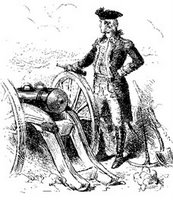A Few Cannon Exchanged on Both Sides
 Selectman Timothy Newell’s biggest worry in early July of 1775 was cannonballs flying into Boston. Here are two more excerpts from his diary:
Selectman Timothy Newell’s biggest worry in early July of 1775 was cannonballs flying into Boston. Here are two more excerpts from his diary:
July 1st. A few cannon exchanged on both sides—one 24 pounder came into the lines, knocked down one Man with the wind of it.A “twenty-four pounder” was a cannon big enough to shoot iron cannonballs that weighed twenty-four pounds. A table prepared at the Royal Military Repository by William Congreve in 1778 listed three types of brass twenty-four pounders: light, medium, and heavy. They were from five feet long to nine and a half feet, and could weight between 1,600 and 5,300 pounds.
2nd Sabbath morning. I waked up by a cannonade from the lines, which continued two hours. A house on the Neck burnt down thereby, which belonged to the town.
As a New Englander, Newell was probably offended by the Royal Artillery’s choice to fire their guns for two hours on a Sunday morning. And as one of Boston’s highest officials, Newell had to keep track of town property, like that burned house on the narrow Neck leading out of town.

No comments:
Post a Comment